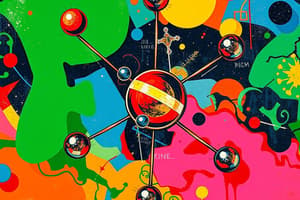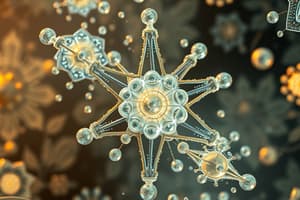Podcast
Questions and Answers
¿Cuál es la partícula más liviana con carga negativa en un átomo?
¿Cuál es la partícula más liviana con carga negativa en un átomo?
- Protón
- Positrón
- Neutrón
- Electrón (correct)
¿Qué tipo de partícula carece de carga eléctrica neta en un átomo?
¿Qué tipo de partícula carece de carga eléctrica neta en un átomo?
- Neutrón (correct)
- Positrón
- Electrón
- Protón
¿En qué parte del átomo se encuentran los protones?
¿En qué parte del átomo se encuentran los protones?
- En el núcleo atómico (correct)
- En la corteza atómica
- En las capas de electrones
- En los electrones
¿Qué función cumplen los neutrones en un átomo?
¿Qué función cumplen los neutrones en un átomo?
¿En cuál componente del átomo se encuentran las capas de electrones?
¿En cuál componente del átomo se encuentran las capas de electrones?
¿Cuáles de las siguientes partículas se encuentran en el núcleo de un átomo?
¿Cuáles de las siguientes partículas se encuentran en el núcleo de un átomo?
Según el principio de Aufbau, ¿cómo se llenan los orbitales atómicos con electrones?
Según el principio de Aufbau, ¿cómo se llenan los orbitales atómicos con electrones?
¿Cuál de los siguientes modelos atómicos describe a los electrones como partículas con propiedades ondulatorias?
¿Cuál de los siguientes modelos atómicos describe a los electrones como partículas con propiedades ondulatorias?
¿Qué tipo de enlace se forma cuando los átomos comparten electrones entre sus capas externas?
¿Qué tipo de enlace se forma cuando los átomos comparten electrones entre sus capas externas?
¿Cuál de las siguientes afirmaciones sobre el modelo atómico de Bohr es correcta?
¿Cuál de las siguientes afirmaciones sobre el modelo atómico de Bohr es correcta?
Study Notes
Atom
Atoms are the fundamental building blocks of all matter, consisting of a nucleus surrounded by one or more electrons. They can be found in every object in the universe, from stars and planets to plants, animals, and you. In this article, we will explore the concept of atoms, their composition, various models outlining how they are structured, the arrangement of electrons within them, and the types of bonds that form between these particles.
Subatomic Particles
An atom is composed of three main types of subatomic particles: electrons, neutrons, and protons. These particles are in constant motion around their nucleus.
Electrons
Electrons, the lightest charged particles found in atoms, carry a negative charge. They orbit the atomic nucleus in a series of energy levels known as electron shells. Electrons consist of two parts: a point mass called the radius, which orbit the nucleus; and an extended part, whose distribution gives rise to the appearance of electric charge.
Neutrons
Neutrons have no net electrical charge and identical masses compared to protons, making them neutral in terms of electricity. They are core components of the atomic nucleus, providing stability through interactions with other neutrons and protons.
Protons
Protons carry a positive charge equal in magnitude to those of the electrons around them. They are located within the nucleus of an atom, which is responsible for determining the atomic number of an element, indicating its position in the periodic table.
Atomic Structure
The nucleus of an atom contains either one or many protons. For example, hydrogen atoms have only one proton in their nucleus, while helium atoms have two protons. Electrons orbit around this nucleus in various energy levels known as electron shells, filling up with electrons in order of increasing energy. These electron configurations determine how elements behave chemically and physically.
Electron Configuration
Electron configuration refers to the arrangement of electrons in different quantum energy states (also called atomic orbitals) in atoms. This arrangement follows specific rules and principles, such as the Aufbau principle, which suggests that when two or more atomic orbitals have the same principal quantum number n, the orbital with lower l will be filled before any other higher l orbital within a subshell.
Atomic Models
Various models have been proposed over time to explain the structure of atoms based on available evidence at the time:
Bohr Model
The Bohr model, developed by Niels Bohr between 1911 and 1913, was one of the first successful attempts to describe the behavior of electrons in atoms using quantum mechanics concepts. It posits a planetary system where a nucleus attracts electrons revolving in circular paths called electron orbits. Over time, it became clear that the Bohr model did not accurately reflect electron motion since electrons can occupy many energy levels simultaneously.
Quantum Mechanics Model
Quantum mechanics offers a modern understanding of atoms by describing electrons mathematically in terms of probability distributions, allowing for a direct comparison with experimental data. In line with the wave-particle duality principle of quantum mechanics theory, electrons exist simultaneously in multiple places across space and possess both particle-like properties and wave-like properties.
Atomic Bonding
Atomic bonding refers to the interactions between atoms that form chemical bonds between them. These bonds can be categorized into several types, including:
Covalent Bonding
Covalent bonds occur when atoms share one or more pairs of electrons between their outermost electron shells, creating a stable electron configuration. This bonding type is found in forming molecules such as H2, H2O, and CO2.
Ionic Bonding
Ionic bonds form when electrons are transferred between atoms, leaving opposite charges on each atom. This transfer results in the formation of ions, which then attract each other due to their opposite charges, forming a solid structure.
Metallic Bonding
Metallic bonding involves the delocalization of electrons in a metal, allowing them to move freely within the material. This bonding type results in a sea of electrons that can move throughout the material.
Hydrogen Bonding
Hydrogen bonding is a weaker type of chemical bond between atoms where hydrogen is covalently bonded to a more electronegative atom or molecule. This noncovalent interaction arises due to electrostatic forces acting between partially positively charged hydrogen atoms and partially negatively charged atoms or molecules.
In conclusion, atoms are fundamental building blocks of matter that can be found everywhere around us. Understanding their subatomic particles, structures, electron configurations, and various types of bonds is essential for grasping the world's chemical interactions and behaviors.
Studying That Suits You
Use AI to generate personalized quizzes and flashcards to suit your learning preferences.
Description
Descubre los fundamentos de la estructura atómica, desde los subpartículas subatómicas que lo componen hasta los distintos tipos de enlaces químicos que se forman entre ellos. Explora modelos atómicos como el de Bohr y la mecánica cuántica, así como los conceptos de configuración electrónica. Comprende cómo los átomos interactúan y se unen para formar moléculas a través de enlaces covalentes, iónicos, metálicos y de hidrógeno.




